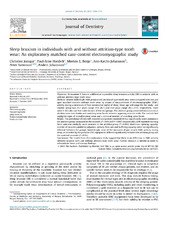| dc.contributor.author | Jonsgar, Christine | en_US |
| dc.contributor.author | Hordvik, Paul-Arne | en_US |
| dc.contributor.author | Berge, Morten Eirik | en_US |
| dc.contributor.author | Johansson, Ann-Katrin Gerd | en_US |
| dc.contributor.author | Svensson, Peter | en_US |
| dc.contributor.author | Johansson, Anders | en_US |
| dc.date.accessioned | 2016-03-23T10:08:45Z | |
| dc.date.available | 2016-03-23T10:08:45Z | |
| dc.date.issued | 2015-12 | |
| dc.Published | Journal of Dentistry 2015, 43(12):1504-1510 | eng |
| dc.identifier.issn | 1879-176X | |
| dc.identifier.uri | https://hdl.handle.net/1956/11746 | |
| dc.description.abstract | OBJECTIVES: To examine if there is a difference in possible sleep bruxism activity (SB) in subjects with or without attrition-type tooth wear. METHODS: Sixteen individuals with pronounced attritional-type tooth wear were compared with sex and aged matched controls without tooth wear by means of measurement of electromyographic (EMG) activity during a minimum of four consecutive nights of sleep. Mean age and range for the study- and control- group was 23.7 years (range 19.9-28.5) and 23.6 years (range 20.3-27.9), respectively. There were 11 females and five males in each of the two groups. The attrition group presented incisal/occlusal attrition wear into dentin and matching wear facets between opposing anterior teeth. The controls had negligible signs of incisal/occlusal wear and a minimal number of matching wear facets. RESULTS: The prevalence of both self-reported and partner-reported SB was significantly more common in the attrition group compared to the controls (P=0.04 and P=0.007, respectively). Self-reported morning facial pain was similarly more common in the attrition group (P=0.014). Maximum opening capacity, number of muscles painful to palpation, salivary flow rate and buffering capacity were not significantly different between the groups. Interestingly, none of the measures of jaw muscle EMG activity during sleep, as recorded by the portable EMG equipment, differed significantly between the attrition group and the matched controls (P>0.05). CONCLUSIONS: The results from this exploratory study suggest that there is no difference in EMG activity between subjects with and without attrition-type tooth wear. Further research is needed in order to substantiate these preliminary findings. | en_US |
| dc.language.iso | eng | eng |
| dc.publisher | Elsevier | eng |
| dc.rights | Attribution CC BY-NC-ND | eng |
| dc.rights.uri | http://creativecommons.org/licenses/by-nc-nd/4.0/ | eng |
| dc.subject | Electromyography | eng |
| dc.subject | Polysomnography | eng |
| dc.subject | Sleep bruxism | eng |
| dc.subject | Temporomandibular disorders | eng |
| dc.subject | Tooth attrition | eng |
| dc.title | Sleep bruxism in individuals with and without attrition-type tooth wear: An exploratory matched case-control electromyographic study | en_US |
| dc.type | Peer reviewed | |
| dc.type | Journal article | |
| dc.date.updated | 2015-12-29T13:00:42Z | |
| dc.description.version | publishedVersion | en_US |
| dc.rights.holder | Copyright 2015 The Authors | |
| dc.identifier.doi | https://doi.org/10.1016/j.jdent.2015.10.002 | |
| dc.identifier.cristin | 1299588 | |

